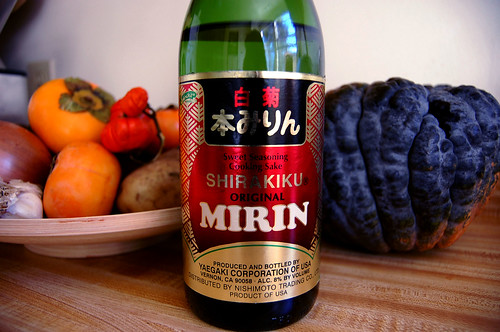
In an effort to demystify Japanese cooking, today's Japanify post is a first in a series I will call "Japanify Ingredients." I've drawn inspiration from some questions I've received from friends, for example: "I bought rice vinegar to make sushi one time, but it's just sitting in my cupboard doing nothing. What else can I do with it?" or "What's the difference between
shoyu and tamari?"
Mirin: The Sugar in Japanese Cooking
First up is
mirin. Mirin can be thought of the sugar element in Japanese cooking. Mirin is a rice wine that is lower in alcohol content (14%) than regular sake (20%). Mirin is made through a fermentation process. Mochi-gome (sweet, sticky rice), kome-koji (rice yeast) and shochu are combined and fermented for two months to produce mirin.
The mochi-gome combination yields a very sweet product - mirin's sugar content is 50%.
Mirin is surprisingly high in sugar yet so ubiquitous in Japanese cuisine. It shows up in everything from teriyaki sauce to marinades and soup broths. (After coming back to the U.S. from a nearly five year stint in Japan, all my meals in the U.S. tasted really sour the first few months). I actually blame mirin for giving me my first cavities in my adult life while I was in Japan.
Functions
Cavity-inducement aside, mirin has several functional characteristics. One of its magical qualities is to get rid of fishy odors. Simmering fish in a mixture of mirin, miso and dashi is true genius since it neutralizes any curious smells.
Mirin also adds umami and depth to simmered vegetables. It enhances the sweetness of carrots, spinach and eggplants without ruining the structure of them (which sugar can do).
Mirin types
One thing to note is that there are two common types of mirin -
hon-mirin ("real" mirin, 本味醂) and
mirin-fu chomiryo (mirin-like condiment 味醂風調味料). The first variety,
hon-mirin, is the real deal with alcohol content at 8% and above.
The second,
mirin-fu chomiryo only is only 1% alcohol yet claims to have the same taste as
hon-mirin.
Mirin-fu chomiryo is cheaper because it avoids certain alcohol taxes. Sure it's cheaper, but in my eyes, it's a fake and I don't like having anything to do with fakes.
Uses
Tsuyu, soba/udon broth (dilute for hot soups):
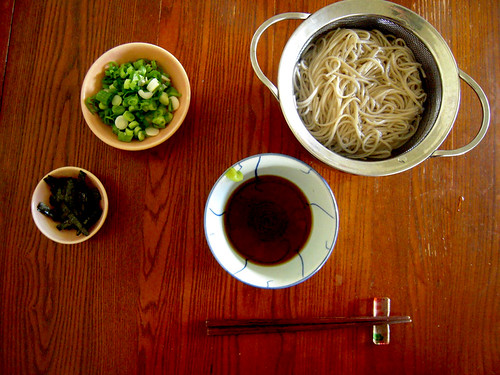 Miso sauce
Miso sauce for fishy fish:
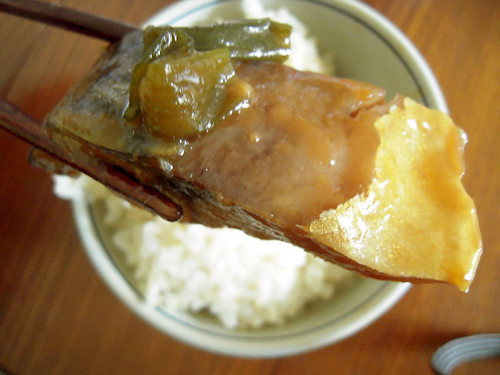 Yakiniku Sauce
Yakiniku Sauce (kind of like Soy Vay; by Yamahomo):
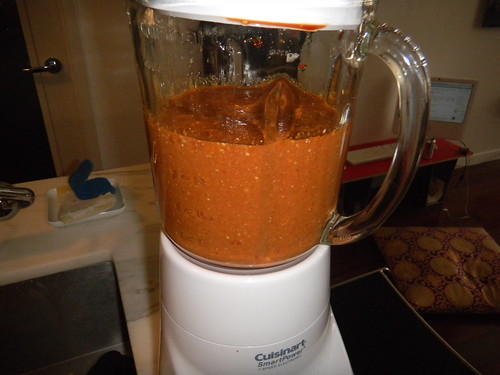
Japanese-style
vegetable marinade (by Sakura):
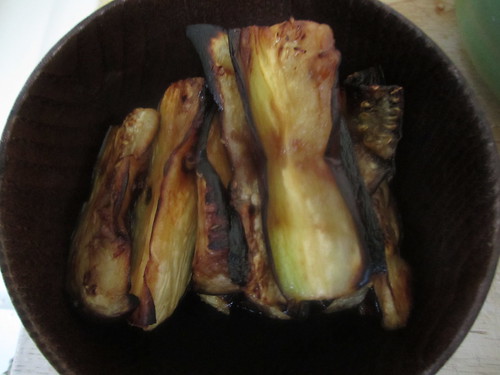
Mirin never goes bad in my book, but it's amazing how fast I go through one 750ml bottle (usually lasting me less than a month). Without mirin I feel castrated in the kitchen. Without mirin - there are no simmered foods, noodle soups or meat marinades in my house.
 In an effort to demystify Japanese cooking, today's Japanify post is a first in a series I will call "Japanify Ingredients." I've drawn inspiration from some questions I've received from friends, for example: "I bought rice vinegar to make sushi one time, but it's just sitting in my cupboard doing nothing. What else can I do with it?" or "What's the difference between shoyu and tamari?"
Mirin: The Sugar in Japanese Cooking
First up is mirin. Mirin can be thought of the sugar element in Japanese cooking. Mirin is a rice wine that is lower in alcohol content (14%) than regular sake (20%). Mirin is made through a fermentation process. Mochi-gome (sweet, sticky rice), kome-koji (rice yeast) and shochu are combined and fermented for two months to produce mirin.
The mochi-gome combination yields a very sweet product - mirin's sugar content is 50%.
Mirin is surprisingly high in sugar yet so ubiquitous in Japanese cuisine. It shows up in everything from teriyaki sauce to marinades and soup broths. (After coming back to the U.S. from a nearly five year stint in Japan, all my meals in the U.S. tasted really sour the first few months). I actually blame mirin for giving me my first cavities in my adult life while I was in Japan.
Functions
Cavity-inducement aside, mirin has several functional characteristics. One of its magical qualities is to get rid of fishy odors. Simmering fish in a mixture of mirin, miso and dashi is true genius since it neutralizes any curious smells.
Mirin also adds umami and depth to simmered vegetables. It enhances the sweetness of carrots, spinach and eggplants without ruining the structure of them (which sugar can do).
Mirin types
One thing to note is that there are two common types of mirin - hon-mirin ("real" mirin, 本味醂) and mirin-fu chomiryo (mirin-like condiment 味醂風調味料). The first variety, hon-mirin, is the real deal with alcohol content at 8% and above.
The second, mirin-fu chomiryo only is only 1% alcohol yet claims to have the same taste as hon-mirin. Mirin-fu chomiryo is cheaper because it avoids certain alcohol taxes. Sure it's cheaper, but in my eyes, it's a fake and I don't like having anything to do with fakes.
Uses
Tsuyu, soba/udon broth (dilute for hot soups):
In an effort to demystify Japanese cooking, today's Japanify post is a first in a series I will call "Japanify Ingredients." I've drawn inspiration from some questions I've received from friends, for example: "I bought rice vinegar to make sushi one time, but it's just sitting in my cupboard doing nothing. What else can I do with it?" or "What's the difference between shoyu and tamari?"
Mirin: The Sugar in Japanese Cooking
First up is mirin. Mirin can be thought of the sugar element in Japanese cooking. Mirin is a rice wine that is lower in alcohol content (14%) than regular sake (20%). Mirin is made through a fermentation process. Mochi-gome (sweet, sticky rice), kome-koji (rice yeast) and shochu are combined and fermented for two months to produce mirin.
The mochi-gome combination yields a very sweet product - mirin's sugar content is 50%.
Mirin is surprisingly high in sugar yet so ubiquitous in Japanese cuisine. It shows up in everything from teriyaki sauce to marinades and soup broths. (After coming back to the U.S. from a nearly five year stint in Japan, all my meals in the U.S. tasted really sour the first few months). I actually blame mirin for giving me my first cavities in my adult life while I was in Japan.
Functions
Cavity-inducement aside, mirin has several functional characteristics. One of its magical qualities is to get rid of fishy odors. Simmering fish in a mixture of mirin, miso and dashi is true genius since it neutralizes any curious smells.
Mirin also adds umami and depth to simmered vegetables. It enhances the sweetness of carrots, spinach and eggplants without ruining the structure of them (which sugar can do).
Mirin types
One thing to note is that there are two common types of mirin - hon-mirin ("real" mirin, 本味醂) and mirin-fu chomiryo (mirin-like condiment 味醂風調味料). The first variety, hon-mirin, is the real deal with alcohol content at 8% and above.
The second, mirin-fu chomiryo only is only 1% alcohol yet claims to have the same taste as hon-mirin. Mirin-fu chomiryo is cheaper because it avoids certain alcohol taxes. Sure it's cheaper, but in my eyes, it's a fake and I don't like having anything to do with fakes.
Uses
Tsuyu, soba/udon broth (dilute for hot soups):
 Miso sauce for fishy fish:
Miso sauce for fishy fish:
 Yakiniku Sauce (kind of like Soy Vay; by Yamahomo):
Yakiniku Sauce (kind of like Soy Vay; by Yamahomo):
 Japanese-style vegetable marinade (by Sakura):
Japanese-style vegetable marinade (by Sakura):
 Mirin never goes bad in my book, but it's amazing how fast I go through one 750ml bottle (usually lasting me less than a month). Without mirin I feel castrated in the kitchen. Without mirin - there are no simmered foods, noodle soups or meat marinades in my house.
Mirin never goes bad in my book, but it's amazing how fast I go through one 750ml bottle (usually lasting me less than a month). Without mirin I feel castrated in the kitchen. Without mirin - there are no simmered foods, noodle soups or meat marinades in my house.




Comments (2)
i love cooking with mirin too!! (and didn’t start until i lived in japan!)
Hey Wen! What do you make with mirin?